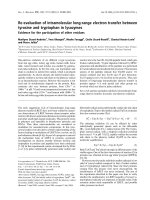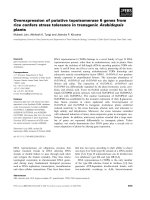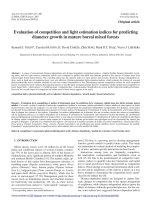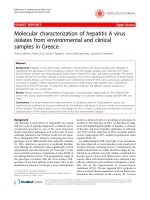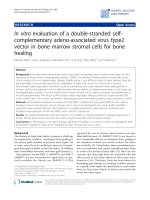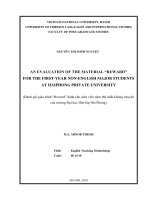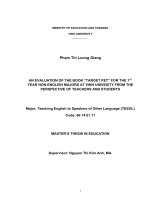Evaluation of flue gas treatment efficiency from honeycomb coal burning process in households at Xuan Dinh ward, Bac Tu Liem district, Hanoi
Bạn đang xem bản rút gọn của tài liệu. Xem và tải ngay bản đầy đủ của tài liệu tại đây (592.75 KB, 9 trang )
Science on Natural Resources and Environment 43 (2022) 114-122
Science on Natural Resources and Environment
Journal homepage: tapchikhtnmt.hunre.edu.vn
EVALUATION OF FLUE GAS TREATMENT EFFICIENCY
FROM HONEYCOMB COAL - BURNING PROCESS IN
HOUSEHOLDS AT XUAN DINH WARD,
BAC TU LIEM DISTRICT, HANOI
Phung Duc Hieu1, Doan Thi Oanh2, Le Nam Anh2
Nguyen Phuong Tu2, Bui Phuong Thuy2, Hoang Ngoc Ha3
1
Institute of Chemistry, Vietnam Academy of Science and Technology
2
Hanoi University of Natural Resources and Environment, Vietnam
3
Hanoi University of Civil Engineering, Vietnam
Received 24 September 2022; Accepted 28 November 2022
Abstract
The air quality in Hanoi is getting worse and worse due to the increase in
population, private vehicles, industrial zones and emission sources from residential
areas. One of the sources of air pollution comes coal burning, which emits many
kinds of substances, such as carbon dioxide (CO2), nitrogen oxides (NOx), carbon
monoxide (CO) and sulfur dioxide (SO2). The use of this energy source is controversial
since it generates hidden indoor air pollution which adversely impacts human health.
Therefore, reducing the concentration or treating air pollutants from coal burning has
great signi�cance in improving air quality and human health. The research investigated
the honeycomb coal burning situation in Xuan Dinh ward, Bac Tu Liem district, Hanoi.
The results of interviewing 23 households with honeycomb coal - burning activities
showed that 56 % of households use 2 - 4 kg of coal/day for business and domestic
purposes. The concentrations of SO2, CO and NOx in the input smoke were quite high,
at 532.89 ± 37.21; 2452.33 ± 45.73 and 28 ± 3.04 mg/m3, respectively. The coal �red honeycomb exhaust gas treatment model using V2O5/TiO2 anatase photocatalysts
showed high e ciency in the reduction of CO (95 %), SO2 (97 %) and NOx (89 %).
Keywords: Household; Coal burning; Flue gases; Air pollution; Treatment.
Corresponding author. Email:
1. Introduction
Coal is used for energy production
in many countries [1, 2, 3]. Coal is used
in commercial electricity, urban areas and
various industries [4, 5, 6]. Approximately
2.8 - 3 billion people use coal for heating
and cooking in their households [7]. In
Poland, about 12 million tons of coal were
114
used in household incinerators for heating
purposes in 2018 [8]. In developing
countries, many households burn wood
and/or coal for heating and cooking [9].
In addition to providing energy bene�ts,
coal combustion releases a signi�cant
amount of emissions generated during
combustion into the atmosphere which
have negative impacts on the environment
and human health [10]. Coal combustion
emissions include mainly CO, CO2, NOx,
SO2 and PM [11,12].
Currently, air pollution from
individual household incinerators emitted
during coal burning is not recorded.
Coal burning for heating and cooking
resulted in hazardous levels of indoor air
pollutants in households in Xuanwei and
Fuyuan. Rural counties in southwestern
China have the highest rates of lung
cancer among never-smokers in the
country [13]. In addition, altered levels of
several circulating immune/in ammatory
markers were found to be associated with
an increased risk of future lung cancer
[14]. In Vietnam, fuel sources such as
honeycomb coal, rewood, agricultural
solid waste and lique ed petroleum gas
(LPG) are the main sources of energy
used for daily cooking. However, the use
of these fuel sources also causes many
indoor environmental pollution problems,
a�ecting human health [15].
Hanoi is the second largest city in
Vietnam with a population of about 8
million people [16]. Studies reported
that some major cities of Vietnam (e.g.,
Hanoi) were among the top 10 air polluted countries in Asia [17]. According
to the study of Hopke et al., (2008), tra c
emissions were the main cause of air
pollution in Hanoi and the concentration
of black carbon - a form of soot generated
from tra c emissions - was very high
[18]. In addition, industrial emissions
and emissions from households’ kitchens
were also sources of air pollution. In
Hanoi, there are still many households,
especially many restaurants, that still
use coal to serve livelihood activities. In
2020, the number of coal stoves in Hanoi
is about 19,3342 [19]. Coal burning is not
only considered a popular cooking tool
in poor households but is also “favored”
by small restaurants. Street vendors, tea,
or fast - food shops often use coal. The
restaurant’s coal stoves are located along
the small alleys, smoke and toxic gases
ow along, ying to the households on the
upper oors, causing a signi cant impact
on the urban beauty and directly a�ecting
the lives of the people around. Xuan Dinh
ward is located in Bac Tu Liem district,
Hanoi, with an area of about 3.52 km2, a
total population of 39,993 people, with a
density of 11,361 people/km². This is a
relatively narrow, crowded area, with a lot
of coal - burning activities. The burning of
coal for business purposes or personal life
has been causing many negative impacts
on air quality, directly a�ecting the health
of users.
Traditional air pollution treatment
techniques include adsorption, separation
and the use of chemical disinfectants,
but all of them share the same aw:
pollutants simply move from one location
to another without being fully eliminated,
or there is the potential for the formation
of byproducts that are toxic to human
health. Photocatalysts can function at room
temperature when exposed to sunlight.
As a result, photocatalytic materials are
a promising element in technology for
air puri cation and reducing the number
of contaminants in the environment of
water. Numerous articles on photocatalytic
materials with considerable application
potential have been published throughout
the world [20]. The recent discovery of
the photocatalytic pollution treatment
technology using nano - TiO2 material
is regarded as a ground - breaking
advancement. When titanium dioxide is
exposed to ultraviolet (UV) radiation,
excited states of electron and hole pairs are
115
produced. These pairs can then interact with
oxygen and water vapor in the atmosphere
to form superoxide ions (O2) and hydroxyl
radicals (OH•). Chemical compounds
can be destroyed by the extremely potent
agents O2 and OH• to produce CO2 and
H2O [21]. Additionally, research revealed
that vanadium - denatured TiO2 materials
could function quite e�ectively in the
visible light region [20].
This study, therefore, conducted
a survey of honeycomb coal - burning
activities in Xuan Dinh ward, Bac Tu Liem
district, Hanoi. The study also evaluated
the composition of coal - red emissions
(NOx, SOx, CO2 and CO) and proposed
technology to apply photocatalysts to treat
coal - red emissions for households.
2. Methods
Household interview method
Conduct eld trips to assess the
honeycomb coal - burning situation in the
study area through survey questionnaires.
The total number of studied households
with honeycomb coal - burning activities
in Xuan Dinh ward, Bac Tu Liem district,
Hanoi was 23. The survey period was
from November to December 2019.
Drawing design method
The drawing of coal - red exhaust
gas treatment model was drawn with
Autocad software - 2010 version.
Measuring ue gas method
Figure 1: Honeycomb coal - �red emission measurement diagram
First, the exhaust gas was sucked
into the inlet ue gas collection chamber.
Then, the ue gas was passed through a
processing device containing the V2O5 /
TiO2 Anatase photocatalyst with visible
light. The treated ue gas was collected
by the outlet ue gas collection chamber.
Inlet and outlet gas measurement results
(NOx, SOx, CO2 and CO) were based on
analysis results from the Testo 350 XL.
The Testo probe was placed perpendicular
to the air ow in the inlet and outlet
chambers.
116
The honeycomb coal - red ue gas
treatment e ciency was calculated by the
following formula:
H = (C0 – Ct)/C0 *100
m)
3
C0: Inlet ue gas concentration (mg/
Ct: Outlet
(mg/m3)
ue gas concentration
H: Flue gas treatment e ciency (%).
Statistical method: Statistics based
on Excel software - 2013 version. The
measured data was entered into the
software for statistics and processing.
3. Results
3.1. Evaluation of the situation of honeycomb coal - burning in households in
Xuan Dinh ward, Bac Tu Liem district, Hanoi
The subjects using honeycomb coal were mainly small businesses and households.
Households used coal for trading, business as well as family activities (Figure 2a).
a)
b)
Figure 2: Purpose of using honeycomb coal - burning (a) and honeycomb
coal - burning percentage based on coal volume (kg/day) (b)
The daily volume of coal used by to use treatment technologies to reduce
households was about 1 - 8 kg (Figure 2b). household air pollution and protect health.
Households burning more than 7 kg of
3.2. Components of inlet honeycomb
coal/day accounted for a low percentage, coal - �red ue gas
only 9 %. Most of the households used 2
In order to evaluate the composition
- 4 kg of coal/day (56 %). According to
statistics on indoor air pollution from the of coal - red exhaust gas, 1 kg of
World Health Organization for the year honeycomb coal was put into the stove.
2020, around 3 billion people worldwide The blower continuously supplied air.
still use charcoal, wood stoves,... for Honeycomb coal can be burned. The
cooking and heating. In 2020, household coal - burning ue gas was collected into
air pollution caused 3.2 million deaths, a chamber and analyzed for content. The
including approximately 237,000 deaths composition of exhaust gas after burning
of children under the age of ve. Exposure honeycomb coal is presented in Table 1.
The concentration of SO2, CO, NOx
to household air pollution increases the
risk of developing non - communicable in the emission was quite high at 532.89
diseases, such as lung cancer, chronic ± 37.21; 2452.33 ± 45.73 and 28 ± 3,04
obstructive pulmonary disease, stroke mg/m3, respectively. The exhaust gas
and ischemic heart disease. The biggest composition after burning coal contained a
health burden from the use of polluting large amount of CO2 with a concentration of
fuels in households is placed on women 4.39 ± 0.08 %. Doan et al., (2016) reported
and children because they are often in that the CO2 and CO concentration in the
charge of household work (e.g., cooking honeycomb coal - red ue gas was about
and collecting rewood) [7]. It is essential 4,64 % and 2000 mg/m3 [20].
117
Table 1. Components of inlet honeycomb coal - �red ue gas (n = 9)
Although the air was supplied
continuously, there was still the presence
of CO in the coal - red exhaust. This
can be explained that the gas retention
time in the burner was not high enough
for the oxygen in the air to contact the
carbon and completely convert CxHy to
CO2. The generation of emissions during
coal - burning can occur due to complete
or incomplete reactions, forming the
corresponding gases. The basic reactions
that take place are as follows [22]:
Incomplete carbon burning reaction:
2CxHy + xO2 = 2xCO + yH2
(1)
Incomplete carbon burning reaction:
CxHy + xO2 = xCO2 + y/2H2
(2)
Compounds containing sulfur + O2
(3)
→
SO2
Compounds containing carbon,
hydrogen and nitrogen + O2 →
CO, NOx, H2O, CxHy.
(4)
- 520 ppmv), CO has minimal side
e�ects that are frequently mistaken for
a cold. These signs include a headache,
lightheadedness, confusion, nausea and
fatigue. Due to its unpleasant e�ects on
the respiratory system, NO2 is a concern
in indoor air. Indoor NO2 concentrations
normally range from 30 to 40 ppbv, with
occurrences as high as 100 ppbv. Indoor
concentrations of SO2 range from 0.5 to
32 lg/m3. The side e�ects of SO2 exposure
include coughing, throat and eye irritation
and di culty breathing [23]. In general,
honeycomb coal - burning emissions
both pollute the environment and a�ect
human health. In this study, the CO
and SO2 concentrations both exceeded
QCVN 19:2009. Thus, the CO and SO2
concentrations in the emission were quite
high and they should be treated before
releasing into the environment.
3.3. Proposing a technology for
treating honeycomb coal - �red emissions
Gaseous
substances
whose for households
concentrations are signi cantly impacted
The data above showed that the
by outdoor levels, such as carbon treatment of coal - red emissions
monoxide (CO), nitrogen oxides (NOx) is really necessary to protect human
and sulfur dioxide (SO2). However, health, air quality, thereby improving
indoor levels can be raised by combustion the quality of human life. However, in
devices, tobacco smoke and incense order to apply treatment technologies to
burning. After using an unvented gas households, treatment equipment must
burner to cook, some Canadian homes’ be inexpensive, compact, suitable for
CO levels have been reported to be as the working space, quality assurance,
high as 115 mg/m3. At low levels (120 safe and sustainable,... In this research,
118
based on survey results on the coal photocatalytic method for treating coal
- burning situation and estimated - red emissions for households has
emissions from coal - burning, the shown its suitability.
(a)
(b)
Figure 3: Technological diagram (a) and elevation (b) for honeycomb coal - burning
emission treatment in households
The operating principle of the
treatment device will be as follows:
Initially, coal - red emissions are collected
into the inlet air collection chamber by an
exhaust fan. The exhaust gas then enters
the treatment system with a reaction
chamber containing a layer of dust lter
cotton for the purpose of retaining dust
particles on this cotton layer. The exhaust
gas then continues to pass through the
V2O5/TiO2 anatase photocatalyst layer.
Here, the exhaust gas will be treated when
it comes into contact with the catalyst
material at room temperature and under
lighting conditions. Finally, the treated gas
continues to go to the outlet air collection
chamber and out to the environment by
the exhaust fan. The treatment model uses
a ow regulator to control the inlet and
outlet ow of the exhaust gas.
3.4. Testing the e ectiveness of
a model using V2O5/TiO2 anatase
photocatalyst in treating smoke from a
honeycomb coal - �red furnace at a semi
- pilot scale
We performed the test on treating
the exhaust gas produced by burning coal
(Figure 3b). The module had a diameter
of 0.7 cm, contained 1 g of photocatalytic
material and was designed by a crystal
module. The exhaust gas was collected
in a gas collector following the treatment
stage. In order to calculate the treatment
e ciency, the concentration of the gas
components was determined.
119
Table 2. Evaluation of the e ciency of honeycomb coal - �red ue gas treatment (n = 9)
The ndings demonstrated that the
exhaust gas produced by burning coal was
e�ectively treated: The converted CO was
greater than 95 %, the converted SO2 was
97 % and the converted NOx was 89 %,
compared to the composition of the input
exhaust gas (Table 2). The concentration
of CO2 that was collected was quite high,
rising from 4.39 % to more than 4.41 %.
The e ciency of NOx and CO gas removal
in this study was higher when using Fe/N/
Co-TiO2 materials with the degradation
rates of NOx and CO under visible light
were 71.43 % and 23.79 %, respectively
[24]. Initial research contributes to
solving the problem of air pollution from
honeycomb coal - burning emissions. In
addition, photocatalysts are also quite
cheap compared to precious metals in gas
treatment, which households can buy and
use, both to solve the problem of indoor
air pollution and to improve their health.
4. Conclusion
The ndings of this study showed
that the daily volume of coal used by
households was about 1 - 8 kg. In which,
households burning more than 7 kg of coal/
day accounted for a low percentage, only 9
%. The highest was 56 %, for households
using 2 - 4 kg of coal/day. Analytical
results showed that the concentration of
SO2, CO, NOx in the inlet ue gas was
quite high at 532.89 ± 37.21; 2452.33 ±
45.73 and 28 ± 3,04 mg/m3, respectively.
The exhaust gas composition after ring
120
coal contains a large amount of CO2 with
a concentration of 4.39 ± 0.08 %. To
reduce the impacts of honeycomb coal red ue gases on the health of people
and the environment, we proposed the
model for coal - red emission treatment
with V2O5/TiO2 anatase photocatalyst,
which can be applied in households and
give high removal of CO (95 %), SO2
(97 %) and NOx (89 %).
Acknowledgements: This work
is supported by a nancial - backed
grassroots science and technology project
in 2022 (13.01.22.k.07).
REFERENCES
[1]. Smil V (2016). Energy Transitions:
Global and National perspectives. 2nd Edition;
ABC-CLIO, LLC: Santa Barbara, CA, USA.
[2]. Munawer M (2018). Human
health and environmental impacts of coal
combustion and post - combustion wastes.
J. Sustain. Min, 17, 87 - 96. Doi:10.1016/j.
jsm.2017.12.007.
[3]. Pavlović B, Ivezić D, Živković M
(2021). State and perspective of individual
household heating in Serbia: A survey - based
study. Energy Build, 247, 111128. https://doi.
org/10.1016/j.enbuild.2021.111128.
[4]. Kubica K, Paradiz B, Dilara P
(2007). Small combustion installations:
Techniques, Emissions and Measures for
Emission Reduction. JRC Scienti c and
Technical Report; EUR 23214 EN - Joint
Research Centre - Institute for Environment
and Sustainability, O ce for O cial
Publications of the European Communities:
Luxembourg. Doi:10.2788/63329;
[5]. Zierold KM, Odoh C (2020). A
review on y ash from coal - �red power
plants: Chemical composition, regulations
and health evidence. Rev. Environ. Health,
35, 401 - 418. Doi:10.1515/reveh-2019-0039.
[6]. Ye J, Zubair M, Wang S, Cai Y,
Zhang P (2020). Power production waste.
Water Environ. Res, 91, 1091 - 1096.
Doi:10.1002/wer.1200.
[7]. WHO (2020). Household air
pollution and health. />news-room/fact-sheets/detail/household-airpollution-and-health, Accessed September
22, 2022.
[8]. GUS - Główny Urząd Stystyczny
(2018). Statistical yearbook of the Republic
of Poland, energy consumption in Households
in 2018. Statistics Poland, Warsaw 2019.
[9]. Rogalsky DK, Mendola P, Metts
TA, Martin WJ. (2014). Estimating the
number of low - income Americans exposed
to household air pollution from burning solid
fuels. Environ Health Perspect, 122(8): 80610.
[10]. Zheng X, Ding H, Jiang L, Chen
S, Zheng J, Qiu M, et al., (2015). Association
between air pollutants and asthma emergency
room visits and hospital admissions in time
series studies: A systematic review and Meta
- Analysis. PLoS One. 10(9): e0138146.
[11]. Deng M, Li P, Ma R, Shan M,
Yang X. (2020). Air pollutant emission
factors of solid fuel stoves and estimated
emission amounts in rural Beijing. Environ.
Int, 138, 106608. />envint.2020.105608.
[12]. Li Q, Qi J, Jiang J, Wu J, Duan L,
Wang S, Hao J. (2019). Signi�cant reduction
in air pollutant emissions from household
cooking stoves by replacing raw solid fuels
with their carbonized products. Sci. Total.
Environ, 650, 653 - 660. Doi:10.1016/j.
scitotenv. 2018.09.020.
[13]. Downward GS, Hu W, Rothman
N, Reiss B, Wu G, Wei F, Chapman RS,
Portengen L, Qing L and Vermeulen R.
(2014). Polycyclic aromatic hydrocarbon
exposure in household air pollution from solid
fuel combustion among the female population
of Xuanwei and Fuyuan counties, China.
Environ Sci Technol 48: 14632 - 14641.
[14]. Li W, Wilker EH, Dorans KS, Rice
MB, Schwartz J, Coull BA, Koutrakis P, Gold
DR, Keaney JF Jr., Lin H, Vasan RS, Benjamin
EJ and Mittleman MA. (2017). Short - term
exposure to air pollution and biomarkers
of oxidative stress: The Framingham heart
study. J Am Heart Assoc 5:5.
[15]. Hoang Anh Le, Dinh Manh Cuong,
Nguyen Thi Kim Anh (2018). Particulate
Matter (PM10, PM2.5, PM1) indoor pollution
by using di erent fuel materials. VNU
Journal of Science: Earth and Environmental
Sciences, 34 (4), 28 - 34.
[16]. General Statistics O ce (2020).
Population forecast of Vietnam in the period
of 2019 - 2069. 181 pages.
[17]. Nguyen TC, Le HT, Nguyen HD,
Le TH, Nguyen HQ. (2021). Estimating
economic bene�ts associated with air quality
improvements in Hanoi city: An application
of a choice experiment. Economic Analysis
and Policy, 71, 420 - 433. https://doi.
org/10.1016/j.eap.2021.06.009.
[18]. Hopke PK, et al., (2008). Urban air
quality in the Asian region. Sci Total Environ,
404(1):. 103 - 112.
[19]. Hanoi Environment and Natural
Resources Department (2020). Statistics of
honeycomb charcoal stoves in the whole of
Hanoi city.
[20]. Doan Thi Oanh, Quach Thi Hoang
Yen, Nguyen Thi Toan, Nguyen Quoc Trung,
Tran Que Chi, Nguyen Hong Chuyen,
Tran Thi Minh Nguyet, Bui Thi Kim Anh,
Dang Dinh Kim (2016). Improvement of
CO2 purifying system by photocatalyst for
application in microalgae culture technology.
Journal of Science and Technology, Vol 54
(1), 92 - 98.
[21]. Thanh Son Le, Trong Hien Dao,
Dinh Cuong Nguyen, Hoai Chau Nguyen
and I L Balikhin, (2015). Air puri�cation
equipment combining a �lter coated by silver
121
nanoparticles with a nano - TiO2 photocatalyst
for use in hospitals. Adv. Nat. Sci.: Nanosci.
Nanotechnol. 6 (2015) 015016 (8pp).
[22]. Tran Ngoc Chan (2002). Air
pollution and exhaust gas treatment. Volume
1. Hanoi Science and Technology Publishing
House, 214 pages.
[23]. Luengas A, Barona A, Hort C,
Gallastegui G, Platel V, Elias A. (2015). A
review of indoor air treatment technologies.
122
Rev Environ Sci Biotechnol. Doi 10.1007/
s11157-015-9363-24.
[24]. Xia H, Liu G, Zhang R, Song
L and Chen H. (2019). The photocatalytic
degradation of vehicle exhausts by a Fe/N/Co
- TiO2 waterborne coating under visible light
materials (Basel), 12(20): 3378.

